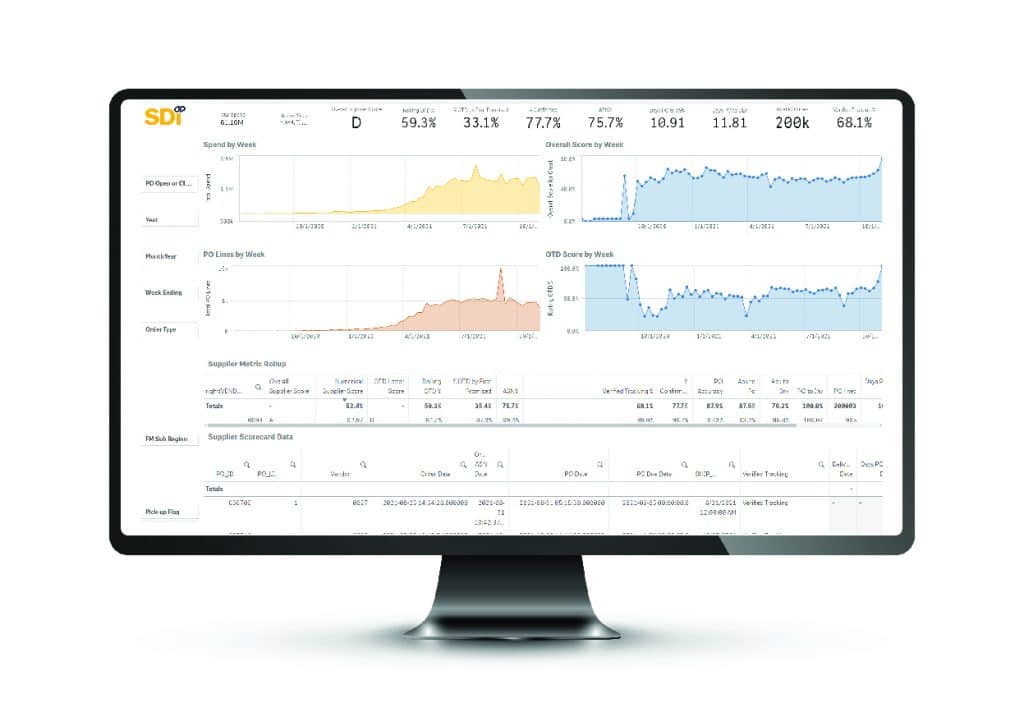SDI is dedicated to helping clients streamline and optimize their maintenance, repair, and operations (MRO) supply chain. As climate, geopolitical, and economic conditions present myriad procurement challenges, SDI’s assistance in forging favorable supplier relationships can manifest in larger revenues and greater profits. As a leading supply chain management company. SDI remains intent on creating client value through efficient negotiation and supplier relationship management (SRM).
The supply chain is complex, often fragmented, and subject to a variety of market conditions. It has evolved into an intricate and integral part of any manufacturing business’s operations strategy.
Understanding each vendor’s position and role within the enterprise’s supply chain enables differentiated engagements and interactions. SRM seeks to develop two-way communication and synergistic strategies with the supply partners most critical to the company’s strategic initiatives. These relationships transform transactional supply operations to a more uniform and integrated process.
Supplier relationship management is made up of 5 primary tasks, and each one is crucial to the success of your companies SRM. Learn more about each component, its value and why your company needs to prioritize these 5 parts of effective supplier relation management.
Five Components of Supplier Relationship Management
1. Categorizing Suppliers
SDI rates suppliers objectively based on their ability to positively influence your efficiency and profit. This supplier-neutral approach differentiates us from most service providers, aggregators, and traditional distributors, whose business models do not include comprehensive supply chain optimization services. We are unbeholden to any supplier; our only agenda is getting you the best prices, contract terms, delivery accommodation, and value in your dealings with suppliers.
The industrial supply chain’s growing elaborateness magnify SDI’s value. As the number of SKUs needed to keep production lines running continuously expands, our ability to track, manage, and secure redundant sources for key supplies become ever more critical. SDI oversees more than 50 distinct commodity categories, dealing with a dynamic ecosystem characterized by high turnover rates in MRO parts required for today’s sophisticated production lines. Recent industry data suggests a turnover rate approaching 70%, leading not only to increased instances of obsolete inventory but also to a significant expansion of the supplier base.
Over time, SDI’s active supplier base ebbed and flowed, expanding with new client acquisitions and market entrants, while contracting through strategic initiatives aimed at identifying high-value partnerships. To counteract uncontrolled growth, we employ a rigorous supplier segmentation process. This methodology helps us pinpoint suppliers with whom we can collaborate most effectively to generate superior value for our customers.
Supplier segmentation is more than just a categorization exercise; it’s a strategic approach to resource allocation within an organization. By segmenting suppliers, we can focus our efforts on managing for value creation rather than solely for performance metrics.
2. Measuring & Improving Supplier Performance
SDI has advanced supplier performance evaluation far beyond mere compliance metrics. While establishing robust contractual relationships and ensuring adherence to agreement obligations remain crucial, that’s just one facet of creating value. An excessive focus on the letter of the contract can potentially detract from the broader value proposition of supplier partnerships.
True, lasting value in supplier relationship management systems lies in innovation and teamwork to overcome supply hurdles. SDI has built a reputation for working with suppliers that consistently deliver exceptional results. Our reputation is inextricably linked to their performance.
Supplier agnosticism ensures we align our tactics seamlessly with our clients’ business objectives, fostering unbiased evaluations, data-driven decisions, and rich supplier relationships. This contrasts sharply with loosely managed and supplier interactions that may compromise service levels and value delivery. Meaningful improvements, supplier performance objectives and measurements driven by matching business goals translate to SDI’s exceeding our customers’ expectations in managing their MRO supply chain. This calls for a multifaceted strategy:
- Holistic Performance Metrics: We’ve expanded our evaluation criteria beyond traditional KPIs to include factors such as innovation contribution, sustainability practices, and adaptability to market changes.
- Real-time Monitoring: Leveraging advanced analytics and IoT technologies, we now track supplier performance as it happens, empowering issue-resolution mobilization before problems fester.
- Risk Management Integration: Supplier performance is now viewed not only through the lens of potential rewards but also in terms of risk abatement, ensuring resilience in our supply chain.
- Customized Point Systems: We’ve developed industry- and customer-specific scorecards that reflect the unique challenges and opportunities within different sectors.
- Value-Added Services: Our evaluation now includes the suppliers’ ability to offer additional and bespoke processes that enhance the overall MRO supply chain efficiency.
- Sustainability Metrics: Environmental and social responsibility factors are now integral to our supplier performance assessments.
3. Becoming a Better Customer
Securing top-tier supplier performance and access to cutting-edge innovations is no longer a given. It’s a privilege reserved for elite, most-favored customers. As an MRO service provider, SDI committed to harnessing the supplier resources, capabilities, and innovations that come with most-favored customer status so we can deliver superior value to our clients.
Positioning ourselves suppliers’ ‘Best Customer’ is only possible through our efforts to understand their perspective, business objectives, and needs. This insight goes beyond surface-level interactions, delving into strategic alignment, financial health, innovation roadmaps, and operational challenges. By aligning your long-term goals with the suppliers’, we create a symbiotic relationship built on mutual growth and financial success. Seeing things from their points of view also provides access to game-changing technologies and an ability to help suppliers recognize and overcome operational hurdles, cementing your seat at the head of the customer table.
Recent industry data suggests that preferred customers receive, on average, 25% more value from their supplier relationships compared to standard customers. We employ several strategies to make sure our clients are counted among this cohort:
- Streamlined Communication: We implement dedicated channels for efficient information exchange, reducing response times by up to 40%.
- Transparent Data: SDI provides clear demand forecasts and insights into your business, enabling suppliers to plan more effectively.
- Leveraged Technology: We integrate systems that facilitate seamless transactions and data sharing, enhancing operational efficiency by up to 30%.
- Prompt Payments: By consistently meeting financial obligations, we build trust and reliability.
4. Collaborating with Suppliers
Over the last few years, it has become trendy to speak of “stakeholder collaboration.” But with supplier relationship management activities, collaboration is more than a buzzword; it’s the cornerstone of a high-performing MRO supply chain. It signifies a shared commitment to achieving common goals, fostering trust, and leveraging diverse expertise to drive operational excellence.
It’s more than mere cooperation. At SDI, collaboration means working with others to complete tasks and achieve shared goals. It’s a process where two or more organizations nurture a deep-rooted partnership built on mutual respect, open communication, and shared vision. It transcends individual objectives to create an alliance where the collective outcome surpasses the sum of individual contributions.
Within the MRO supply chain, collaboration can revolutionize how organizations operate. By fostering strong relationships with suppliers, manufacturers, and internal stakeholders, companies can unlock significant value. This includes:
- Enhanced Visibility: Real-time data sharing and collaborative forecasting enables more precise inventory ordering levels, reducing stockouts, and improving order fulfillment.
- Swift Remediation: Collaborative problem-solving roots out problems early, enabling fast fixes and solutions that address the causes rather than merely the symptoms.
- Cost Containment: By sharing best practices and leveraging economies of scale, organizations can achieve reduce waste, redundancies, and other excess expenses.
- Customer Satisfaction: A well-coordinated supply chain leads to higher product availability, faster delivery times, and enhanced customer service.
SDI leverages its vast MRO supply chain network to unlock the full potential of your operations.
5. Improving Supplier Quality
In targeted and cooperative supplier relationship management strategies, substantial opportunities exist to enhance supplier quality. This stems, in part, from consistent investment in supplier meetings that address all facets of business performance. Additionally, data exchange related to product failures across diverse client environments plays a pivotal role. Effective capture of this data occurs when an MRO service provider utilizes purpose-built tools designed for warranty management, service, reparability, and MRO item maintenance.
To learn more about SDI’s approach to supplier relationship management and how it gives us the edge over our competitors, contact us today.





